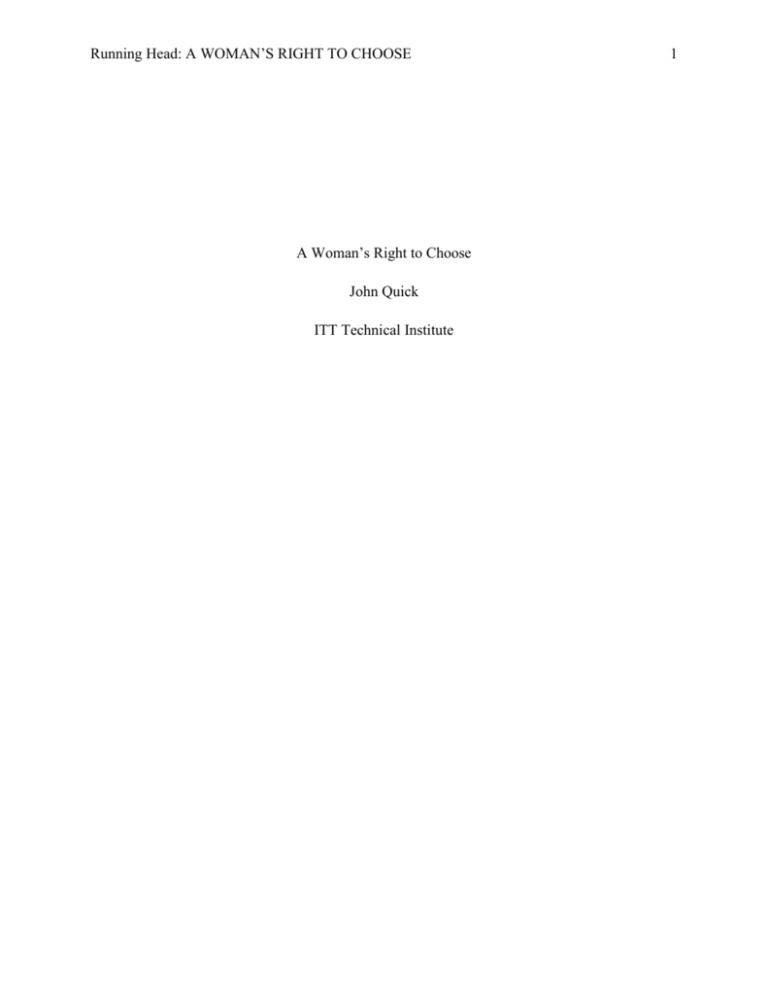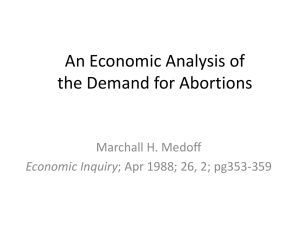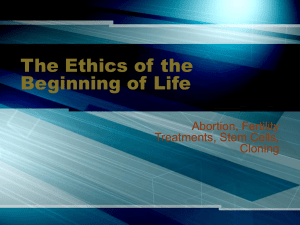A woman`s right to choose
advertisement

Running Head: A WOMAN’S RIGHT TO CHOOSE A Woman’s Right to Choose John Quick ITT Technical Institute 1 A WOMAN’S RIGHT TO CHOOSE 2 Abstract The issue of abortion is a widely controversial debate, and has been for years. When is it right, if ever, to take away a woman’s right to legal and safe, regulated abortions? The right to choose continuing a pregnancy should lie firmly on the shoulders on the mother, herself, and no one else. In this paper I will look at major points in the pro-life arguments, and argue scientific, statistical and logical evidence against them. A WOMAN’S RIGHT TO CHOOSE 3 The decision of abortion and a woman’s ‘right to choose’ is one of the most controversial discussions in America and the world today. Although the arguments centering on the morality of the issue are widely stated, more practical and information driven arguments are not nearly as prevalent in today’s conversations. When making a decision on your particular stance on the subject, there is more to look at than simply the morality of the act of an abortion itself. While a small number of our population is undecided, the vast majority of Americans identify with one of the two sides of this debate, typically referred to as “pro-life” or “pro-choice”, both backed by a significant number of people. The purpose of this argument is to address some of the major prolife arguments and present a reason why they may not be supported by scientific, or logical evidence, as well as illustrate why access to safe and legal abortion may be essential to our current way of life. Where Does the Debate Start? The term abortion, according to the Merriam-Webster dictionary, is the termination of a pregnancy after, accompanied by, resulting in, or closely followed by the death of an embryo or fetus. In today’s society there are many reasons a woman may choose this option instead of childbirth including cases of rape or incest that result in pregnancy, the woman involved may not be financially or mentally capable of handling the conceived burden of a child, or possible health issues that may present themselves to either the mother or the fetus involved. In any of these cases, who is right to decide what a woman does with her body, especially when it concerns her own body. Most of our current laws on the matter stem from a prominent court case held in A WOMAN’S RIGHT TO CHOOSE 4 1973, Rowe v Wade, where it was argued that "A pregnancy to a woman is perhaps one of the most determinative aspects of her life. It disrupts her body. It disrupts her education. It disrupts her employment. And it often disrupts her entire family life. And we feel that, because of the impact on the woman, this … is a matter which is of such fundamental and basic concern to the woman involved that she should be allowed to make the choice as to whether to continue or to terminate her pregnancy." (S. Weddington, Roe v Wade). Rowe v Wade was the most public and prevalent case arguing laws set on abortions, yet there are still major issues from pro-life protestors. How Does This Affect our Society? Abortion is legal to an extent in the US and many other countries worldwide. In fact, according to data collected from the CDC, in 2001 there were 853,485 legal abortions in the US, with 73.1% of these being performed within the first trimester; a staggering number, but still much less than in earlier years (averaging over 1.3 million/year between 1977 and 1997). Now think about those numbers for a second. Given that abortions in America make up just a small percentage of the worldwide numbers, and that overpopulation is always a continuing concern in our world with limited resources already, we can argue that having the capability of accessing safe, regulated abortions helps to continue the quality of life for the entire human race. By creating more strict laws in legal abortions, we may possibly be putting women at a higher risk as those that may want abortions but can’t legally obtain them may find a way to receive them elsewhere, in a possibly more unsafe environment, but should the government step aside and let this decision rest solely on mother? My answer to this is no. There should be laws set in place, however, we should allow a woman faced with the want or need for an abortion to A WOMAN’S RIGHT TO CHOOSE 5 have the ability to do so in the safest way possible. Even with this, the argument stands whose rights are more important, the right to life of the mother, or the unborn fetus? Main Pro-Life Arguments There are many arguments against abortions presented by the pro-life side of this epic debate, many of which have been restated again and again. These deal with the morality of the act of abortion itself, as well as arguments concerning the safety of both the mother and proposed unborn life. Morality of Ending a Life The first and most prevalent of these arguments is that abortion is immoral because life begins at conception. Before we can ask if this is true, we must think about what constitutes human life. If life ends when the heart stops, should it not begin with the same? A heart develops enough to have a heartbeat at around 6 weeks (although this won’t be able to be seen or heard in an ultrasound until typically week 8). If we conceive that even if there is a heartbeat, there is still not a fully developed brain, or capability of active brain function until week 12 after conception, should week 12 then be the standard for life given that there is a heartbeat and developed brain? A current standard could also be what is called the ‘quickening’, or the first movement of a fetus, which doesn’t occur until even later in a pregnancy, between weeks 13-18. This is the current benchmark for the majority of the laws concerning abortions today. Putting a Mothers Life in Danger A WOMAN’S RIGHT TO CHOOSE 6 The second most common argument is that abortion is an unsafe practice that puts the mothers’ life in danger. This is simply untrue as there is no scientific or statistical evidence to support this claim if we are discussing legal abortion. Obviously every medical procedure comes with health related risks involved, the same as any surgery to any other part of your body, but according to the Guttmacher Institute, "The risk of abortion complications is minimal: Fewer than 0.3% of abortion patients experience a complication that requires hospitalization. Abortions performed in the first trimester pose virtually no long-term risk of such problems as infertility, ectopic pregnancy, spontaneous abortion (miscarriage) or birth defect, and little or no risk of preterm or low-birth-weight deliveries. The risk of death associated with abortion increases with the length of pregnancy, from one death for every one million abortions at or before eight weeks to one per 29,000 at 16–20 weeks—and one per 11,000 at 21 or more weeks." Arguably, abortions are less of a health risk than actual childbirth, since the mortality rate of having a child is ten times higher than that of having an abortion at a legal provider. Quality of Life Should abortion options be made available in the event that the mother life would be at serious risk during a pregnancy? Should she not also have the right to abort if evidence arose that the fetus would have detrimental and unavoidable defects that could affect the length of, or the quality of the life it may live? At this point whose rights are more worth protecting? If someone can claim a right to live, shouldn't they have some sort of independent life of their own? A fetus is only able to live because it is attached by the to the circulatory system of the mother by way of the umbilical cord and womb; therefore, any claim to a "right" to live must necessarily be at the expense of the woman. (A. Cline, n.d.) If the mothers wellbeing, either physically, mentally, or financially will be in jeopardy if she were to continue with the pregnancy, she should be able to A WOMAN’S RIGHT TO CHOOSE 7 decide whether or not to terminate it. If she were mentally or financially unable to take care of a child, the child would then suffer, causing the child to be in danger of neglect, thus affecting its quality of life. Conclusion In conclusion there is much more going on behind these arguments than you may imagine, which is possibly why this is such a deeply rooted controversial issue that will most likely be around for decades to come. Most of the claims made by pro-life debaters cannot completely be dismantled until our own scientific knowledge has advanced further, however, if we continue to put more restrictions on abortions, or outlaw them all together, the women seeking them, will continue to look for ways around these laws even if it is resorting to ‘back ally’ providers. If this is the case the repercussions and mortality rate will most assuredly increase, harming our society more than doing it good. When it comes to the rights we enforce, a woman’s right to choose what he does with her own body, especially before a fetus has even developed enough to have a heartbeat, or brain functionality, is not for anyone else but her to decide. A WOMAN’S RIGHT TO CHOOSE 8 Annotative Bibliography Various Authors. (2013). “Does human life begin at conception?” | Debate.org. Retrieved from http://www.debate.org/opinions/does-human-life-begin-at-conception. Various arguments are presented as the opinions of multiple people. Showing both sides of the argument on when a human life is considered life at all. Authors bring ethical, moral, and biblical arguments to the table, although, being a public debate forum, one must look past the various fallacies in a few of the arguments where someone may make a point and then attack the person who feels the opposite simply based on their stance directly, instead of disproving, or making a counter point. However, the points made are valid and most hold substance. Alters, S. M. (2008). “Abortion in the United States: A Statistical Study.” Abortion: An Eternal Social and Moral Issue. Retrieved from http://ic.galegroup.com.proxy.itttech.edu/ic/ovic/ReferenceDetailsPage/ReferenceDetailsWindow?failOverType=&query=& prodId=OVIC&windowstate=normal&contentModules=&displayquery=&mode=view&displayGroupName=Reference&limiter=&u=itted&currPage=&disa bleHighlighting=true&displayGroups=&sortBy=&source=&search_within_results=&p=O VIC&action=e&catId=&activityType=&scanId=&documentId=GALE%7CEJ3011820104 Compiled statistical information compiled from the Center for Disease Control (CDC) as well as the US Department of Health and Human Services, and the Guttmacher Institute, a privately owned entity that polls abortion providers around the world. This statistical page holds a wealth of information including why women have, where they may go for, as well as the availability of abortion providers. Mikula, M., & Mabunda, L. M. (1999). Roe v Wade. Great American Court Cases. Retrieved from http://ic.galegroup.com.proxy.itttech.edu/ic/ovic/ReferenceDetailsPage/ReferenceDetailsWindow?failOverType=&query=& prodId=OVIC&windowstate=normal&contentModules=&displayquery=&mode=view&displayGroupName=Reference&limiter=&u=itted&currPage=&disa bleHighlighting=true&displayGroups=&sortBy=&source=&search_within_results=&p=O VIC&action=e&catId=&activityType=&scanId=&documentId=GALE%7CEJ2303200554 An analytical look at the 1973 case Roe v Wade, in which a single woman, Norma McCorvey, as a representative of all pregnant women under the alias of ‘Jane Roe’ helped to overturn Texas state laws regarding abortions against Texas district attorney Henry B. Wade. With her help, Texas lifted restrictions on first term abortions, as well as build solid regulations on second trimester abortions as long as the pregnancy puts the mother’s own life at risk. Jones, C. (2013). Women Seeking Abortions Should Not Be Forced to Undergo an Ultrasound. Retrieved from http://ic.galegroup.com.proxy.itt- A WOMAN’S RIGHT TO CHOOSE 9 tech.edu/ic/ovic/ViewpointsDetailsPage/ViewpointsDetailsWindow?failOverType=&query= &prodId=OVIC&windowstate=normal&contentModules=&displayquery=&mode=view&displayGroupName=Viewpoints&dviSelectedPage=&limiter=&u=itt ed&currPage=&source=&disableHighlighting=&displayGroups=&sortBy=&zid=&search _within_results=&p=OVIC&action=e&catId=&activityType=&scanId=&documentId=GA LE%7CEJ3010869214 One woman’s firsthand traumatic experience of some Texas state mandated regulations. These include mandatory sonograms with a description of the baby, lectures from her doctor, and a 24 hour waiting period, even after her and her husband had made an educated, yet still emotional, decision as their child would have been born with massive health problems. This article concludes with an explanation that she may not have had to go through the entire process given her particular circumstances, but due to the complexity of the laws and regulations, and the haste in which they were put into effect, there were no clear guidelines as to how the abortion providers were to implement these changes. Cline, A. (n.d.). When Does a Fetus Become a Person with Rights? Retrieved from http://atheism.about.com/od/abortioncontraception/p/PersonhoodFetus.htm A compelling argument for a woman’s right to choose abortion with consideration to the fetus itself. The author shares his views on when exactly one might consider a fetus a life in and of itself, as well as sturdy arguments against the legality of observing a woman’s right to control her own body including letting another being, in this case a fetus, use hers to sustain life, and other aspects of abortion debate. Hinman, L. M. (2012, March 19). Ethics Updates - Abortion & Ethics. Retrieved from http://ethics.sandiego.edu/Applied/Abortion/index.asp#PageCite This page includes a number of Gallop polls and Guttmacher Institute statistics. Also included with all of this information is, in simple terms, various court rulings pertaining to abortion laws, as well as a number of those laws themselves.





